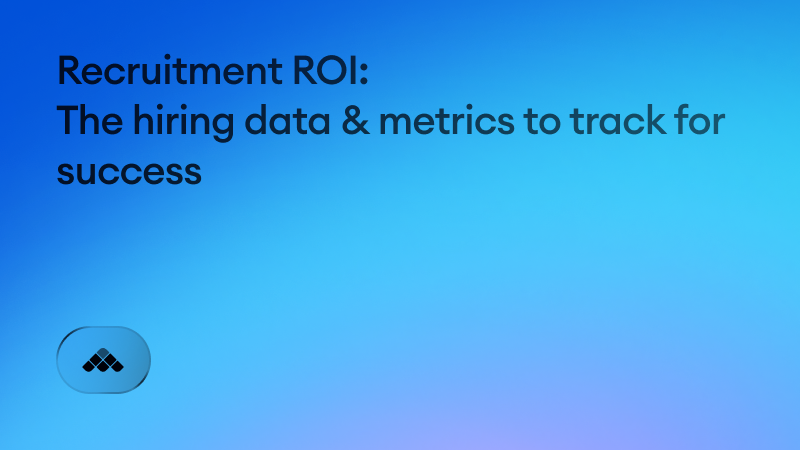Every modern company strives to be data-driven. But when it comes to hiring, many still struggle to connect their recruiting activity to measurable business outcomes. Talent teams know they play a critical role in company growth, but proving that impact often feels elusive.
There’s good reason to care about and track your recruitment ROI. You can clearly show how recruiting contributes to business performance. Not just by filling roles, but by driving productivity, retention, and revenue.
Talent leaders who can link hiring data to business impact win more influence, more resources, and more trust across the organization. Recruitment ROI gives you the framework to do exactly that.
Key takeaways
- Recruitment ROI connects hiring to business value. It’s not just about filling open roles, it means demonstrating how talent drives measurable impact across the company.
- Data and automation make ROI visible. AI tools unify data from sourcing, interviews, and performance to reveal real-time insights into what delivers results.
- You have the data, but exploiting it is hard. Choose the right tools and processes to bring key insights together, and highlight your biggest strengths.
What is recruitment ROI?
Recruitment ROI (Return on Investment) measures how effectively your hiring process turns resources—time, money, and effort—into business value. It goes beyond efficiency metrics like time to hire or cost per hire, evaluating the true payoff of bringing in the right people.
In simple terms, recruitment ROI helps answer:
- Are our hiring investments generating measurable business returns?
- How do the people we hire contribute to company performance over time?
- Where can we allocate recruiting budget for the biggest impact?
Unlike operational metrics, which focus on process optimization, ROI measures outcomes. It bridges the gap between talent acquisition and financial performance, translating hiring success into language executives understand: value creation.
If your new hires generate more revenue, improve productivity, or reduce turnover, that’s tangible ROI. Conversely, poor-quality hires, long ramp-up times, or high attrition rates signal negative ROI, and therefore wasted spend and lost opportunities.
Why measure recruiting ROI?
Measuring ROI in recruitment helps provide visibility, accountability, and influence. When you can quantify impact, you elevate recruiting from a support function to a strategic partner.
Here are a few of the key motivators for measuring ROI:
- Prove the value of talent acquisition: This is the fundamental benefit. ROI shows how hiring drives growth, retention, and performance, to justify your budget and headcount.
- Guide smarter investments: By knowing which recruitment channels, roles, or teams deliver the best ROI, you can prioritize resources where they’ll make the biggest difference.
- Align with business goals: When recruiting metrics mirror the language of finance and strategy, talent teams gain credibility with leadership.
- Spot inefficiencies early: Tracking ROI reveals hidden costs like repeated hiring for the same role, or low retention in certain departments.
- Support continuous improvement: With clear ROI visibility, teams can refine talent sourcing strategies, interview processes, and onboarding to maximize long-term returns.
Suppose a SaaS company finds that engineers sourced through employee referrals stay 40% longer and reach full productivity 25% faster. By doubling down on referrals, they increase recruiting ROI without raising costs, simply by investing in what worked best.
Formula: How to calculate hiring ROI
Calculating recruitment ROI starts with a simple principle: compare what you invest in hiring to the measurable value those hires create. Often, this isn’t done with real, hard financials.
Teams (and company executives) tend to reflect more on how quickly they feel open roles are closed, and the perceived quality of new hires. For many organizations, that’s fine.
But if you do want to look for financial results, here’s one way to quantify hiring ROI.
Recruitment ROI = (net benefits of hiring / total recruiting costs) × 100
Where:
- Net benefits of hiring = value generated by hires – total recruiting costs
- Total recruiting costs = all expenses related to talent sourcing, tools, recruiter salaries, job ads, assessments, and onboarding.
In practice, this formula adapts based on your business model. For example:
- Revenue roles (sales, customer success): Measure direct revenue generated by new hires versus cost to recruit and onboard.
- Product or engineering roles: Estimate ROI based on productivity gains, innovation output, or reduced time-to-market.
- Support roles: Evaluate efficiency improvements, customer satisfaction impact, or cost savings from improved performance.
Example: If your company spent $150,000 on recruiting five engineers, and those hires contributed an estimated $900,000 in new project value in their first year, your ROI is:
((900,000 − 150,000) / 150,000) ×100 = 500%
A 500% return on your recruiting investment is a clear and compelling story to tell leadership.
Beyond the formula: qualitative ROI
Not all ROI is numeric. The qualitative impact of hiring (stronger culture, better leadership, or improved collaboration) is equally valuable. Pairing qualitative insights with quantitative data gives you a holistic view of how hiring contributes to organizational success.
Build evidence for this by asking hiring managers how satisfied they are with new team members, or by looking at retention rates and performance reviews. It’s not always easy to put real dollar figures on people’s value to the organization, but you can build strong arguments in other areas.
How AI and automation deliver better ROI in recruitment
Artificial intelligence and process automation are transforming how companies achieve and prove strong recruiting ROI.
Historically, tracking ROI meant collecting fragmented data across spreadsheets, ATS systems, and performance tools. That approach misses real-time context and slows down decision-making.
Today, AI-powered recruiting analytics change that dynamic. Automation continuously captures, analyzes, and connects hiring data, giving you instant visibility into performance and efficiency.
Here’s how AI improves recruitment ROI across the hiring funnel:
- Reduces manual effort: Automates sourcing, screening, and scheduling, saving recruiter hours and cutting process costs.
- Finds trends in huge datasets: You wouldn’t ask humans to pore over endless interview transcripts and sourcing metrics. But AI tools can do it in seconds, continuously.
- Improves quality of hire: Machine learning models highlight candidate patterns that correlate with successful employees.
- Shortens time-to-hire: Intelligent routing and scheduling eliminate bottlenecks, keeping candidates engaged and reducing drop-offs.
- Enhances decision quality: Automated analysis surfaces which interviewers, questions, or competencies predict the best outcomes.
- Supports continuous optimization: Real-time dashboards show which strategies yield the highest return, so teams can pivot faster.
AI doesn’t just track ROI, it improves it.
How Metaview enhances recruitment ROI
Every interview is a goldmine of qualitative data about candidate quality, decision rationale, and team alignment. Yet most of that information is lost in fragmented notes and memory.
Metaview transforms your underutilized interview notes into detailed, actionable insights. Suddenly, you have a wealth of structured, useful data at your fingertips. And the AI Reports tool uncovers meaningful trends and builds the narrative you need to prove your value.
Plus, there are key operational benefits that make your team more productive and impactful:
- Automatic transcription and summarization mean recruiters and hiring managers spend less time on admin, and more on decision making.
- Structured interview analytics turn conversations into quantifiable data to show patterns in skills, interviewer behavior, and decision bias.
- Faster, higher-quality decisions reduce time-to-hire and improve offer acceptance rates, both of which drive ROI.
- Continuous insights reveal where hiring processes can be streamlined or improved for long-term gains.
- Integration with ATS and reporting tools ensures your recruiting data flows seamlessly, creating a unified view of cost and impact.
By using Metaview, talent teams move from reactive reporting to proactive improvement. You boost efficiency, improve quality of hire, and prove recruiting’s business value with hard data.
Measure and improve recruiting ROI today
Data-backed hiring empowers teams to make smarter investments, justify resources, and continuously improve. When you can measure and communicate your recruitment ROI, you transform talent acquisition from a cost center into a strategic growth engine.
And with AI and automation, the process no longer needs to be complex or manual. You can track impact in real time and tie every decision to measurable value.
Metaview helps teams do exactly that. By automatically capturing and analyzing your interview data, it turns every hiring conversation into actionable insights that reveal what’s working, what’s not, and where your biggest ROI opportunities lie.
Recruiting leaders who embrace ROI thinking today will define the future of talent tomorrow.
Try Metaview for free and see how AI can help you prove, and improve, your hiring ROI.


